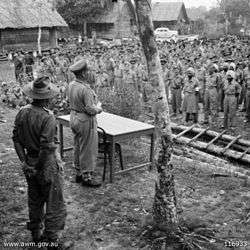2/10th Field Regiment (Australia)
| 2/10th Field Regiment | |
|---|---|
|
Liberated troops, including those from the 2/10th, at the Japanese surrender at Kuching, September 1945 | |
| Active | 1940–45 |
| Country | Australia |
| Type | Regiment |
| Role | Artillery |
| Part of | 22nd Brigade, 8th Division |
| Engagements | |
| Insignia | |
| Unit Colour Patch |
|
The 2/10th Field Regiment was an Australian Army artillery regiment formed in mid-1940 as part of the Second Australian Imperial Force during World War II. The regiment was deployed to Malaya in 1941, taking part there in the military actions against the Japanese, and then deployed to Singapore in early 1942. When the garrison was surrendered, the majority of the regiment were taken prisoner and remained in captivity until the end of the war in August 1945.
History
Raised as part of the 8th Division, the regiment was formed at Redbank, Queensland, and initially consisted of two batteries of First World War-vintage 18-pounders; these were designated as the 19th and 20th Batteries. Later, in January 1941, the regiment was expanded to a third battery, initially designated as X Battery before being redesignated as the 60th. The following month, the regiment moved by rail to Sydney, where they embarked for overseas, deploying to Malaya, where they joined the 22nd Brigade Group, which had been sent to help bolster the British garrison.[1][2]
Initially based in Malacca, the regiment later moved to Mersing on the east coast, where the 22nd Brigade took up defensive positions. During the initial fighting in the Malayan Campaign after the Japanese invasion on 8 December, the regiment was not actively engaged. In early January 1942, they were re-equipped with 25-pounders and on 21 January they provided support for Australian troops fighting around the Mersing–Endau Road. For the rest of the month, the regiment participated in further actions as the British and Commonwealth troops were forced back along the Malay Peninsula towards Johore. In early February, after withdrawing across the Johore Causeway to Singapore Island, the two Australian brigades – the 22nd and 27th – took up defensive positions, the 22nd in the western sector and the 27th in the north in preparation for a Japanese assault. Within the defensive plan, the 2/10th was responsible for covering the causeway sector.[1][2]
On 8 February, the Japanese assault came from across the Johore Strait, falling predominately upon the 22nd Brigade's positions. Prior to the attack, the regiment had formed an extra troop of guns equipped with 4.5-inch howitzers as well spare 18-pounders, and during the assault these were used to fire on sampans carrying Japanese troops across the water. Although they sunk over 30 of them, the defenders were overwhelmed and pushed back inland. Over the course of the next week, the regiment was heavily engaged, firing thousands of rounds and continuing to fire its guns until the end of the campaign, which ended when the British garrison commander, Lieutenant General Arthur Percival, ordered a surrender.[1][2]
After this, the regiment's personnel became prisoners of war. Over the next three-and-a-half years, they were scattered throughout the Pacific to camps in Singapore, Malaya, Borneo, Thailand, Burma and Japan. Subjected to poor conditions and used for hard labour, many of the 834 men from the 2/10th who were captured were killed or died in captivity – a total of 270 men – before being freed when the war ended in August 1945.[1] The regiment's casualties during the war amounted to 286 killed and 16 wounded.[1]
References
- 1 2 3 4 5 "2/10th Field Regiment". Second World War, 1939–1945 units. Australian War Memorial. Retrieved 28 June 2014.
- 1 2 3 Morgan, Joseph (2013). "A Burning Legacy: The 'Broken' 8th Division". Sabretache. Garran, Australian Capital Territory: Military Historical Society of Australia. LIV (3): 4–14. ISSN 0048-8933.
Further reading
- Goodwin, Robert (1995). Mates and Memories: Recollections of the 2/10th Field Regiment R.A.A. Rochedale, Queensland: Boolarong Press with 2/10th Field Regiment Association. ISBN 9780646221663.
- Goodwin, Robert (2000). Medicos and Memories: Further Recollection of the 2/10th Field Regiment R.A.A. Rochedale, Queensland: Boolarong Press with 2/10th Field Regiment Association. ISBN 9780646334783.
- Wigmore, Lionel (1957). The Japanese Thrust. Australia in the War of 1939–1945. Series 1—Army, Volume IV. Canberra, Australian Capital Territory: Australian War Memorial. OCLC 3134219.
